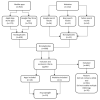Assessing the Content and Quality of Digital Tools for Managing Gestational Weight Gain: Systematic Search and Evaluation
- PMID: 36427237
- PMCID: PMC9736757
- DOI: 10.2196/37552
Assessing the Content and Quality of Digital Tools for Managing Gestational Weight Gain: Systematic Search and Evaluation
Abstract
Background: Digital health resources have the potential to assist women in optimizing gestational weight gain (GWG) during pregnancy to improve maternal health outcomes.
Objective: In this study, we aimed to evaluate the quality and behavior change potential of publicly available digital tools (websites and apps) that facilitate GWG tracking.
Methods: Digital tools were identified using key search terms across website search engines and app stores and evaluated using the Mobile App Rating Scale, the App Behavior Change Scale, as well as criteria to evaluate the rigor and safety of GWG information.
Results: Overall, 1085 tools were screened for inclusion (162 websites and 923 apps), and 19 were deemed eligible. The mean Mobile App Rating Scale quality score was 3.31 (SD 0.53) out of 5, ranging from 2.26 to 4.39, and the mean App Behavior Change Scale score was 6 (SD 3.4) out of 21, ranging from 19 to 0. Of the 19 items used to evaluate rigor of GWG advice, most tools (n=11, 57.9%) contained ≤3 items.
Conclusions: This review emphasizes the substantial limitations in current digital resources promoting the monitoring and optimization of GWG. Most tools were of low quality, had minimal behavior change potential, and were potentially unsafe, with minimal linkage to evidence-based information or partnership with health care.
Keywords: digital; gestational; pregnancy; tracking; weight.
©Bonnie R Brammall, Rhonda M Garad, Jacqueline A Boyle, Melanie J Hayman, Susan J de Jersey, Helena J Teede, Quoc V Hong, Alayna Carrandi, Cheryce L Harrison. Originally published in the Journal of Medical Internet Research (https://www.jmir.org), 25.11.2022.
Conflict of interest statement
Conflicts of Interest: None declared.
Figures
References
-
- Gilmore LA, Klempel-Donchenko M, Redman LM. Pregnancy as a window to future health: excessive gestational weight gain and obesity. Semin Perinatol. 2015 Jun;39(4):296–303. doi: 10.1053/j.semperi.2015.05.009. https://europepmc.org/abstract/MED/26096078 S0146-0005(15)00044-0 - DOI - PMC - PubMed
-
- Whincup PH, Kaye SJ, Owen CG, Huxley R, Cook DG, Anazawa S, Barrett-Connor E, Bhargava SK, Birgisdottir BE, Carlsson S, de Rooij SR, Dyck RF, Eriksson JG, Falkner B, Fall C, Forsén T, Grill V, Gudnason V, Hulman S, Hyppönen E, Jeffreys M, Lawlor DA, Leon DA, Minami J, Mishra G, Osmond C, Power C, Rich-Edwards JW, Roseboom TJ, Sachdev HS, Syddall H, Thorsdottir I, Vanhala M, Wadsworth M, Yarbrough DE. Birth weight and risk of type 2 diabetes: a systematic review. JAMA. 2008 Dec 24;300(24):2886–97. doi: 10.1001/jama.2008.886.300/24/2886 - DOI - PubMed
-
- Gluckman PD, Hanson MA, Cooper C, Thornburg KL. Effect of in utero and early-life conditions on adult health and disease. N Engl J Med. 2008 Jul 03;359(1):61–73. doi: 10.1056/NEJMra0708473. https://europepmc.org/abstract/MED/18596274 359/1/61 - DOI - PMC - PubMed
Publication types
MeSH terms
LinkOut - more resources
Full Text Sources


